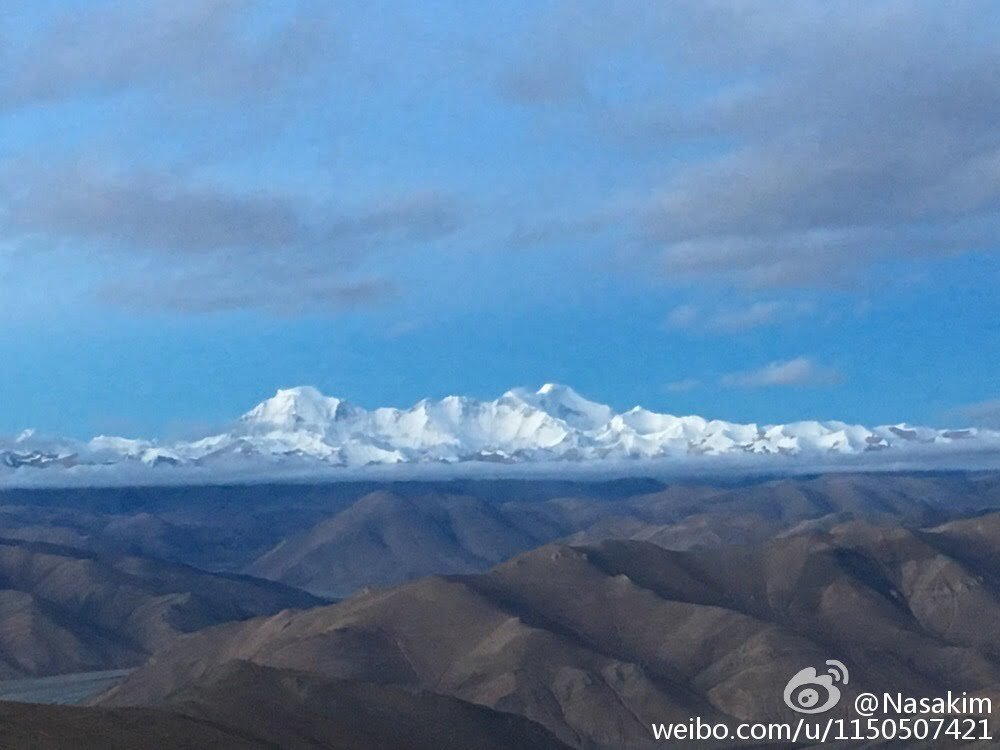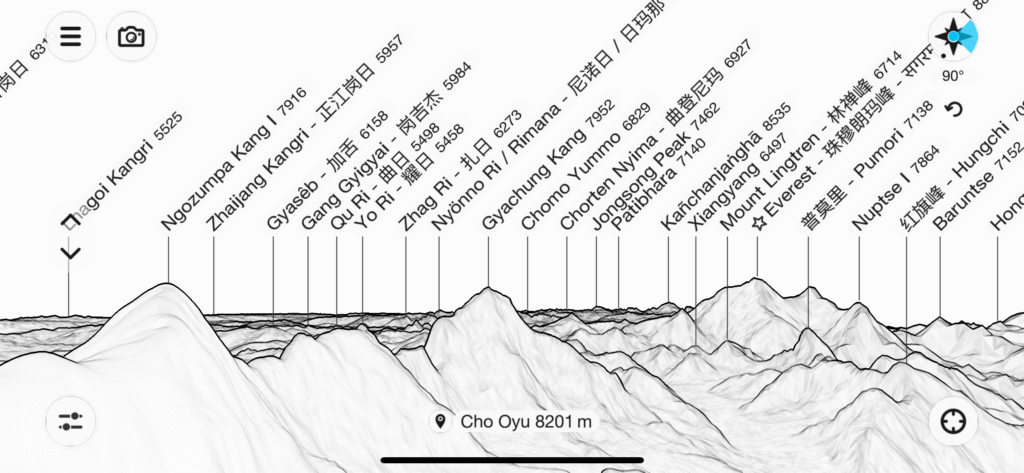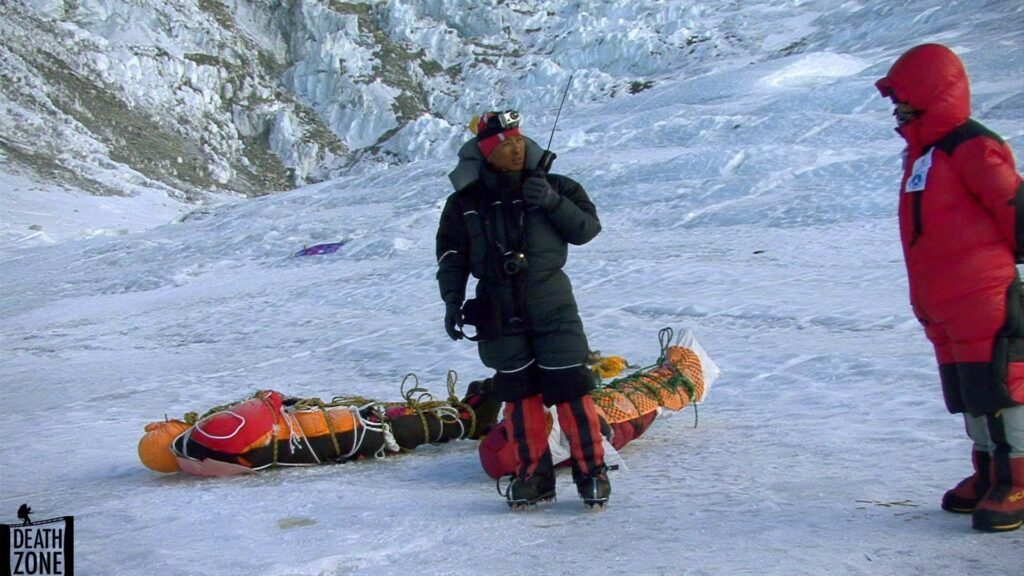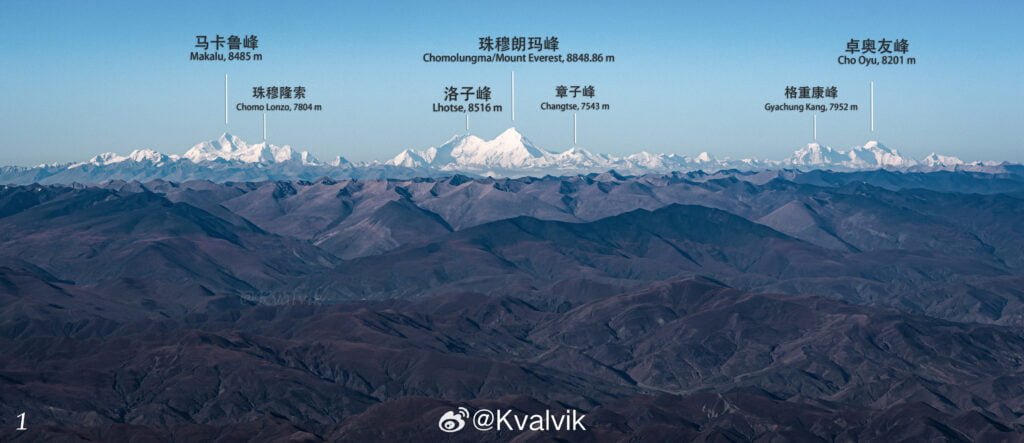The “God Bald” Mountain
Cho Oyu, standing at an altitude of 8,201 meters, might not catch your eye at first glance due to its seemingly ordinary appearance. However, it holds a special place in the hearts of climbers. Known as the “Chief Spiritual Teacher” in Tibetan, Cho Oyu rests on the border between Tingri County in Shigatse, Tibet, and Nepal. Locals affectionately call it Jowo Oya (ཇོ་བོ་དབུ་ཡ), which translates to the “God of Baldness.” This name comes from a unique legend depicting Cho Oyu as a deity who, following a soured love affair, chose to shave his head and permanently turn his back on his love interest, Mount Everest.
A Tale of Unrequited Love
According to local folklore, Cho Oyu and its neighboring six peaks were once close siblings. Over time, Cho Oyu fell deeply in love with Mount Everest, also revered as the “Third Goddess.” Unfortunately, Everest ended up marrying Makalu Peak, leaving Cho Oyu heartbroken. In his despair, he shaved his head, vowing never to marry, and twisted his head westward, away from Everest. This poignant love story has earned Cho Oyu great respect and affection from the local community, with many devotees coming annually to pay their respects at its base.
A Majestic Neighbor to Everest
Cho Oyu lies approximately 30 kilometers east of Mount Everest (8,844.43 meters), the world’s highest peak, and west of Shishapangma (8,012 meters), the fourteenth highest. Majestically situated in the heart of the Himalayas, a breathtaking array of snow-capped peaks surrounds Cho Oyu, presenting a spectacular view.

The Glaciated Giant of Cho Oyu
The mountain is perennially covered in snow and glaciers, featuring five main ridges: northwest, northeast, southwest, southeast, and west. Notable peaks in its vicinity include Baruntse Peak (7,013 meters) to the northwest, Shixing Peak (7,308 meters) to the north, Gelong Peak (7,975 meters) and another unnamed peak (7,882 meters) to the east, and Menlungtse (7,175 meters) and Tseringma (7,134 meters) to the southwest.
Cho Oyu stands as the world’s sixth-highest peak among the fourteen over 8,000 meters and ranks among the 44 peaks Tibet has opened for climbing, with locals regarding it as a sacred mountain. Its profound story and the stunning natural beauty that surrounds it make Cho Oyu a captivating destination for mountaineers and spiritual seekers alike, offering both a challenging climb and a window into the deep cultural reverence for mountains in the region.

Cho Oyu: The Sacred Guardian of the Himalayas
The Deity Among Peaks
Locals of Tibetan ethnicity revere Cho Oyu as a divine guardian overseeing peace and order in the region. Legend has it that Cho Oyu permits only cattle and sheep to pass, forbidding horses and donkeys, and appoints a horse-head shaped rock to guard its gates. Any high-headed horse that dares to cross is doomed to be buried under an avalanche. Once, a wealthy merchant tried to deceive the mountain by fixing cow horns to his horses, only to meet disaster just beyond the pass, leading to a longstanding avoidance by horses and donkeys. While legends are just that, Cho Oyu continues to stand tall and proud among the surrounding peaks, piercing the sky with its grandeur.
The Seven Majestic Peaks
Cho Oyu is flanked by seven magnificent peaks, affectionately called the “Seven Siblings.” The first is named “Jo Rowa Satsa,” symbolizing great power; the second, “Chi Joya,” meaning an elder; the third, “Jo Ugyen Shangsha,” representing a hatted Buddha; the fourth, “Jo Agang Bangang,” indicating rough terrain; the fifth, “Danten Jo,” known for its beauty and intelligence; the sixth, “Josha Buga Mani,” embodying literary grace and wisdom; and the seventh, “Jo Dalingam,” the goddess of the white world. Four of these siblings lie within China’s borders, while the other three reside in Nepal’s Khumbu Glacier region.
A Plateau of Snow
The summit of Cho Oyu features a large, gently sloping snowfield, resembling the wise, bald head of an elder from afar. The mountain’s glaciers, including the Kabula Glacier on the north side and the Lhakpa Glacier on the south, flourish above 5,700 meters. These glaciers’ melting zones are adorned with ice towers, forming a vibrant landscape of ice gullies, caves, and bridges. Between 6,900 and 7,200 meters lies a zone of icefalls, where steep terrain causes glaciers to hang like solid waterfalls, creating a spectacular sight.

The Changing Climate of Cho Oyu
Cho Oyu experiences variable weather, with October to March marking the windy season, when winds can reach speeds of 50 meters per second, and temperatures often range between -30°C and -40°C. The monsoon season spans from June to September. The transitional periods, from late April to late May and from September to October, offer the best conditions for mountaineering, making these months the most suitable for climbing endeavors.
Mount Cho Oyu, not just a mountain but a cultural and spiritual symbol, stands as a testament to the deep reverence the local communities have for the natural world, embodying the rich tapestry of Himalayan lore and landscape.
Popular Cho Oyu Expedition Unveils Prehistoric Wonders
Sixth-Highest mountain, Cho Oyu: A Geological and Paleontological Marvel
The “Peak Mission” team from the Cho Oyu paleontological expedition has made groundbreaking discoveries in the Cho Oyu region. A scientific research team uncovered shark fossils dating back to the late Triassic period, around 220 million years ago. These findings fill a crucial gap in the marine ecological chain of that era.
Triassic and Cretaceous Revelations
In layers from the late Cretaceous period, approximately 70 million years ago, the team found ammonites, illustrating genetic disturbances in some biological groups before the fifth mass extinction. Ammonites, emblematic cephalopods evolved from the Devonian period, were widespread in Triassic seas and became extinct by the end of the Cretaceous. They serve as “index” fossils for geologists to date rock layers, like the Jurassic ammonite fossils common in the Everest region.
Researchers discovered fossils of Berberis, Cotoneaster, and Spruce from the Pliocene era, around 5 million years ago, at altitudes above 4,800 meters. This suggests a coniferous forest existed in the Himalayas during the uplift of the Tibetan Plateau, surpassing 3,000 meters in elevation.
The Himalayas’ Late Uplift
Including famous peaks like Everest, Shishapangma, and Cho Oyu itself, the sixth-highest peak in the world at 8,201 meters, the Himalayas are a focal point in the significant geological event of the Tibetan Plateau’s uplift. The Himalayas’ uplift was relatively late, rapidly rising between 25 and 20 million years ago, with the current plateau formation occurring around 15 million years ago. The journey to Cho Oyu Base Camp encapsulates millions of years of geological, climate, environmental, and biological evolution details of the Qinghai-Tibet Plateau, enlightening more people on the environmental changes and life evolution history of this ancient sea, the Tethys Ocean, over two hundred million years ago.

Cho Oyu: Triumphs and Trials of the “God of Baldness”
Climbing Cho Oyu, affected by glaciers and harsh weather, has always been a formidable challenge. On October 19, 1954, an Austrian climbing team, with the help of Sherpas, achieved the first successful summit. In 1959, French climber Marie Goegg-Pouchoulin led an international women’s team in an attempt that unfortunately ended in tragedy. On May 1, 1985, the Tibetan climbing team marked a milestone by being the first Chinese climbers to conquer Cho Oyu.
On April 21, 1998, the Peking University climbing team reached the summit, pioneering the ascent for domestic amateur teams. The first successful ascent by a joint Sino-Japanese women’s climbing team occurred on October 1, 2002, with 11 members reaching the top. On September 21, 2004, Chen Siqi from Hangzhou, an amateur mountaineer, became the first to summit Cho Oyu without supplemental oxygen.
Practical Tips for Aspiring Climbers
- Getting There: The journey to the base camp at the end of the Kabula Glacier begins in Lhasa, traveling south along the South Tibet Road through Shigatse, Lhatse, and Tingri, then another 40 kilometers south. The base camp, located at an elevation of 4,959 meters, offers a broad, wind-sheltered terrain with ample water sources.
- The Climbing Route: The northwest (or west-northwest) route on Cho Oyu’s north slope is considered the most established and is commonly referred to as the traditional climbing route. From the summit, climbers are rewarded with views of Everest, Lhotse, Makalu, and numerous other peaks.
These achievements underscore Cho Oyu’s status not only as a challenging peak but also as a symbol of international collaboration and individual perseverance in the mountaineering community. Its slopes have witnessed the spirit of adventure, the depths of tragedy, and the heights of triumph, continuing to inspire climbers from around the world.

Great Post , Thank you for sharing